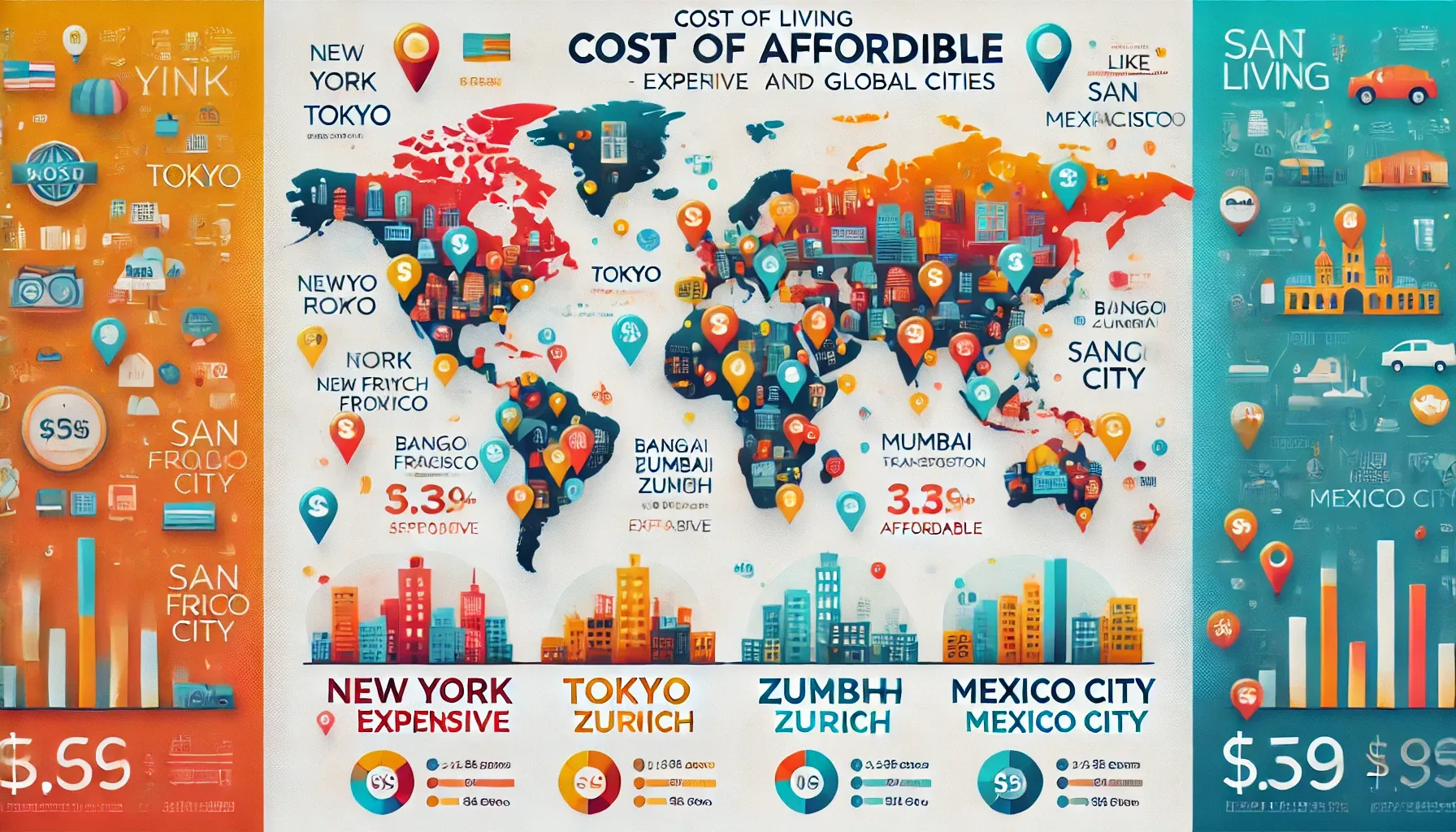How did the ranking of the most expensive cities in the world change in 2017?

- What are the most expensive cities in the world in 2023?
- Why is life in large cities becoming increasingly expensive?
Global cost of living
The ranking produced by the Economist Intelligence Unit has been publishing semi-annual reports titled "Global Cost of Living" for over a hundred years. This document examines price indicators for more than 160 categories of goods and services in various cities around the world. The included positions relate to categories such as food, beverages, clothing, household items, personal hygiene products, rental rates, transportation costs, utilities, private education, and entertainment.
Every March and September, analysts from the Economist Intelligence Unit collect data on over 50,000 real prices for various goods and services worldwide. The assessment uses information from different types of retail establishments: supermarkets, mid-range stores, and specialty boutiques. Ultimately, all prices are converted into their equivalent in US dollars.
Prices in cities around the world
Let's take a look at which cities occupied the top and bottom spots in the rankings as of March 2017. It might be interesting to analyze the situation regarding housing prices in the most expensive cities in the world.
The megacities of East Asia continue to dominate the rankings. This year, just like in the previous three, the top spot is held bySingaporeThe following areHong KongandZurich, which are located in the second and third positions respectively. Japanese citiesTokyoandOsakaThey also maintained their positions in the top ten, with Tokyo, which once held the first place until 2012, rising seven spots due to the strengthening of the yen.
Thus, five out of the ten most expensive megacities are located in Asia, which confirms the growing economic influence of this part of the world. The other four cities are in Western Europe, with the only American city on the list beingNew York, which shifted from seventh to ninth place due to the decline in the dollar's exchange rate, which, in turn, also affected other cities in the USA.
Price dynamics in New York
It should be noted that over the past five years, New York has only ranked 46th in this same rating. Considering the weakening of the dollar and the stability of the euro, currencies such as:
- Canadian dollar
- Australian dollar
- New Zealand dollar
significantly strengthened their positions, which allowed cities likeSydney,Melbourne,WellingtonandAucklandto be among the top 20 most expensive settlements.
Comparison of Zurich and Geneva
Zurich and Geneva continue to be among the ten most expensive cities, even despite a slight decrease in the cost of living in these cities. Zurich ranks third, while Geneva shares seventh place with Paris. Interestingly, life in Paris is currently about7%more expensive than in New York, whereas five years ago this difference was50%.
Product categories and final analysis
Despite Singapore continuing to be the most expensive city in the world, it still falls behind competitors in certain categories, such as hygiene products and household goods. However, it is worth noting that this city still ranks first in the cost of purchasing and renting cars, and it is second in clothing prices.
Ultimately, the analysis indicates that the cost of living in the most expensive cities in the world continues to rise, which is linked to economic trends in various countries. It raises the intriguing question of how the locations of cities will change in the future against the backdrop of global economic shifts and currency fluctuations.
High cost of living in large cities
In terms of food and drink costs, Singapore is comparable to Shanghai, highlighting the high living standards in these major cities. Currently, Singapore has secured the title of the most expensive city in the world, while Hong Kong comes in second, followed by Zurich and Tokyo.
The top ten most expensive metropolises also include Osaka, Seoul, Geneva, Paris, New York, and Copenhagen.
Key changes in American cities
Although the only American city on this list is New York, Los Angeles continues to hold a prominent position, despite its ranking dropping from eighth to eleventh place.
9 October 2024
29 September
9 October 2024




The rise of Seoul and the decline of Chinese cities
The phenomenon of Seoul's growth is interesting, as it was in 50th place just seven years ago and has now risen to sixth place. This sharp increase stands in stark contrast to the decline of Chinese cities, where economic indicators have been pressured by both the weakening yuan and a decrease in consumer spending.
The cost of living in Paris and Copenhagen
Paris, being the only representative of the Eurozone in the top 10, continues to be one of the most expensive cities to live in. It is worth noting that in this city, alcohol and tobacco products are significantly cheaper than in other cities in Europe. Copenhagen also maintains high rankings due to its substantial prices for essential goods and public transport services.
Prices for essential goods
Prices for basic goods vary in different megacities. In particular:
- In Singapore, one kilogram of bread costs approximately3.55 dollars...and a 750 ml bottle of wine will cost...23.68 dollars.
- A pack of 20 cigarettes costs about9.63 dollars.
- In Hong Kong, a kilogram of bread can be purchased for4.61 dollarsIn Zurich, its price reaches5.66 dollars.
Analyzing the data, it becomes clear that Tokyo stands out for its high food prices, but at the same time, it has relatively low gasoline prices compared to other major cities in the ranking.
Changes in the oil market and their impact
In 2016, the oil market faced serious challenges, which overall led to a slowdown in the decline of commodity prices. This, in turn, contributed to a decrease in the inflation rate in several countries. However, the situation in developing countries unfolded differently, especially in regions where the local currency lost its value. Some of the countries that relied on resource extraction experienced a sharp rise in inflation rates.
The situation in the cities of Brazil and Argentina
For example, Brazilian cities like São Paulo and Rio de Janeiro have shown the most significant growth:
- São Paulo has risen to29 positions.
- Rio de Janeiro on27 positions.
At the same time, the weakening of the Argentine peso has negatively affected Buenos Aires, which has fallen to20 positionsdown, finding oneself atin 82nd placeHowever, this decline is not considered the most critical among all the cities being examined. Other cities have also experienced changes in their rankings, but Singapore, Hong Kong, and Tokyo still occupy the top spots in this ranking, maintaining their reputation as expensive places to live.

Introduction
In conclusion, the analysis of the cost of living in various cities around the world, based on data from the Economist Intelligence Unit, highlights many interesting trends and patterns. In recent years, we have witnessed significant changes in the global economy that have affected the prices of goods and services. As the author of this study, I want to emphasize that although Singapore and Hong Kong continue to top the list of the most expensive cities, the economic situation in other regions is also of great interest.
Trends in price increases
It is important to note that capital cities in Asia, such as Seoul and Tokyo, have significantly risen in the rankings due to economic stability and the strengthening of their local currencies. This indicates that modern economies are capable of quickly adapting to changing conditions that affect the cost of living.
The impact of currency fluctuations
Another important point is that against the backdrop of overall price increases worldwide, we are seeing fluctuations for many cities depending on currency exchange rate variations, which leads to cities like New York dropping in the rankings.
The rise and fall of cities
It is also worth noting that the development of resource-dependent cities, such as São Paulo and Rio de Janeiro, demonstrates the potential for significant growth even in the face of global instability. However, at the same time, the detachment of some cities, such as Buenos Aires, serves as a reminder offragilityeconomic systems.
Conclusion
So, this ranking highlights how dynamic the global markets are and how they can change from year to year. For future economists and real estate professionals, this provides important data that can help in forecasting and making informed decisions.
One thing remains clear:By observing such rankings, we can not only understand where it is worth living or investing, but also get a sense of the spirit of the global economy, which is constantly changing and evolving.
Comment
Popular Posts
9 October 2024
1485
29 September
356
9 October 2024
9935
Popular Offers

Subscribe to the newsletter from Hatamatata.com!
Subscribe to the newsletter from Hatamatata.com!
I agree to the processing of personal data and confidentiality rules of Hatamatata








